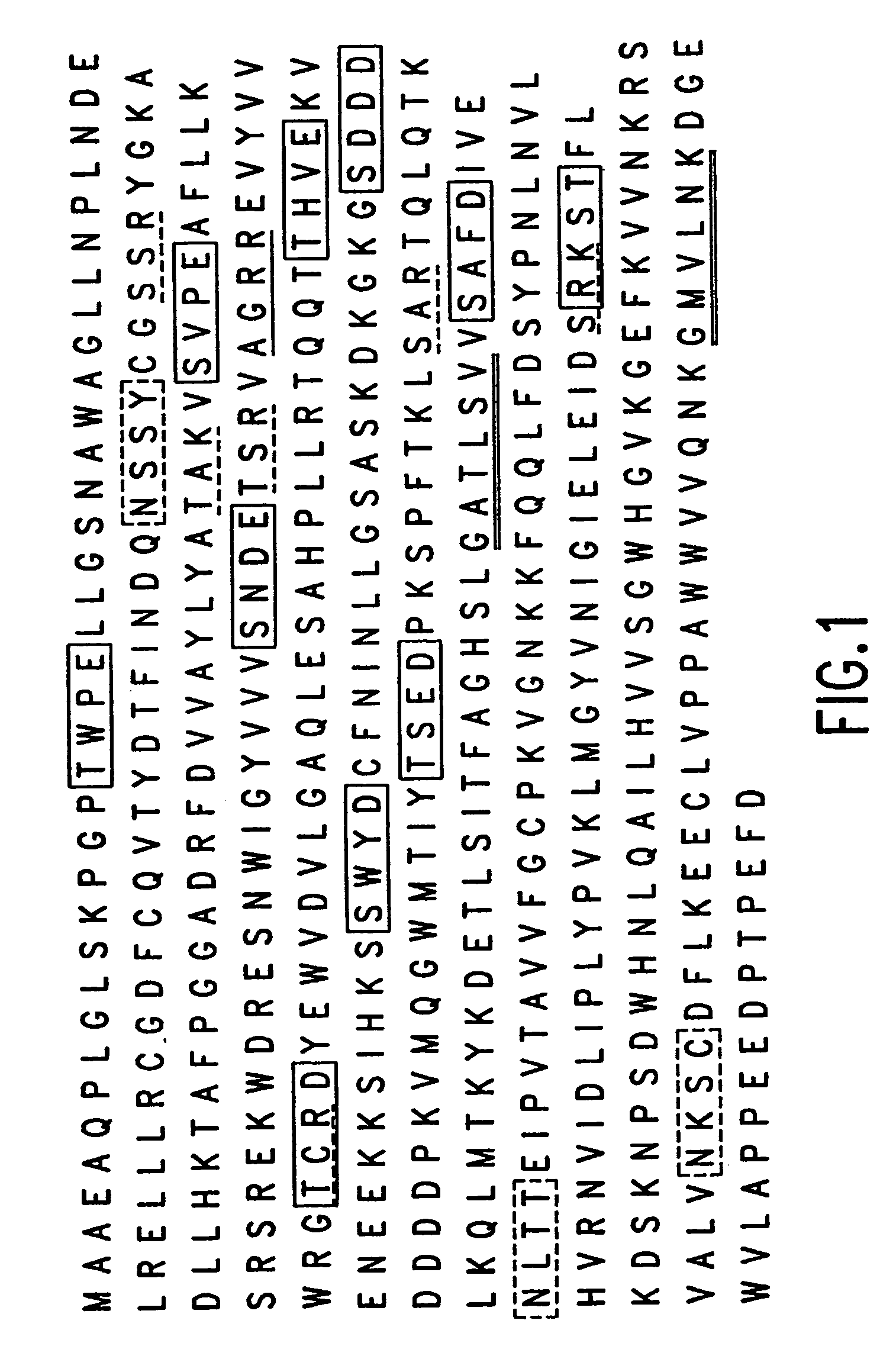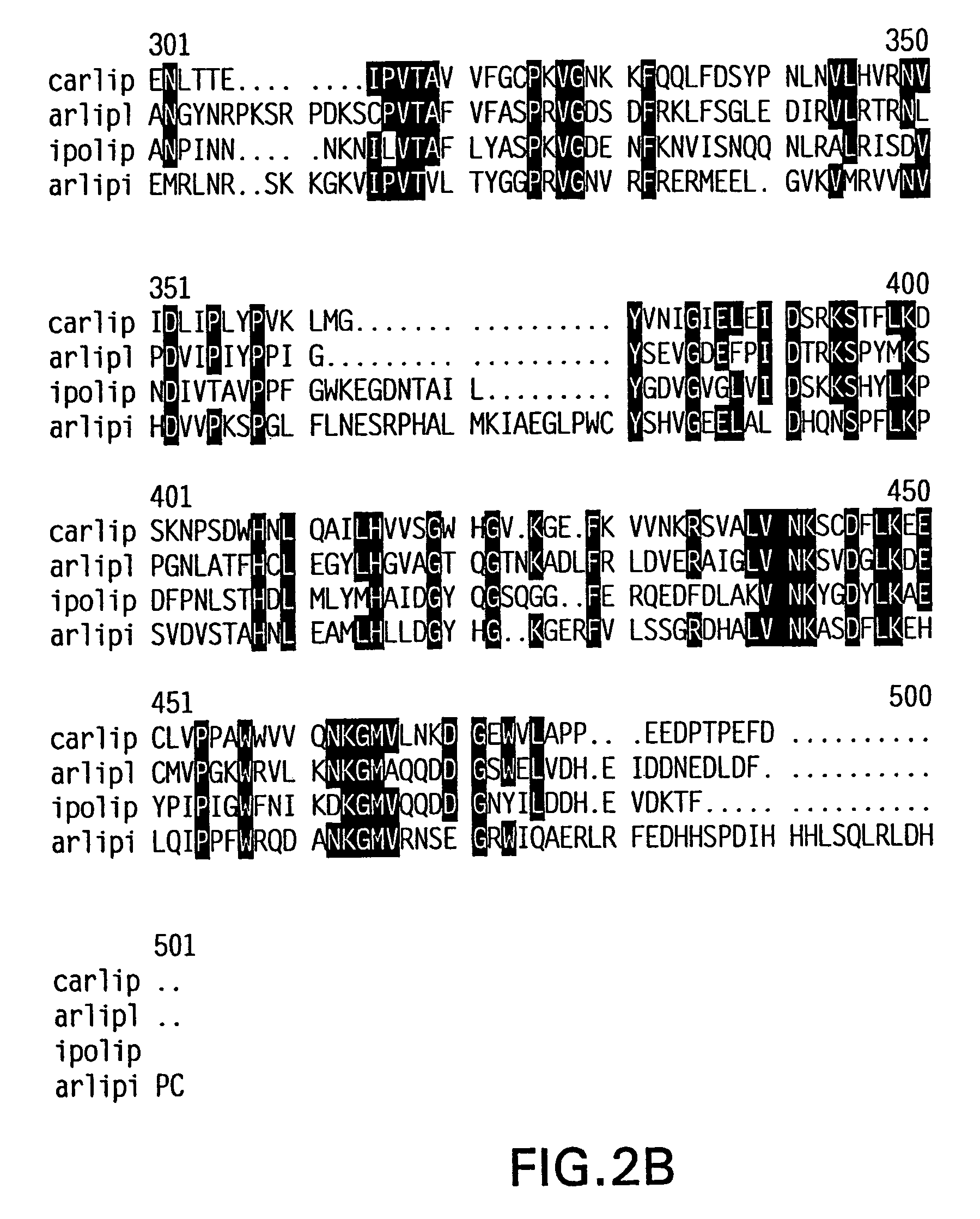DNA encoding a plant lipase, transgenic plants and a method for controlling senescence in plants
a plant lipase and coding technology, applied in the direction of dna/rna fragmentation, plant/algae/fungi/lichens ingredients, depsipeptides, etc., can solve the problems of initiation of senescence, no widely applicable method for controlling the onset of senescence caused by either internal or external forces
- Summary
- Abstract
- Description
- Claims
- Application Information
AI Technical Summary
Benefits of technology
Problems solved by technology
Method used
Image
Examples
example 2
Ethylene Induction of Carnation Senescence-Induced Lipase Gene
Stage II carnation flowers and carnation cuttings were treated with 0.5 ppm ethylene in a sealed chamber for 15 hours. RNA was extracted from the ethylene treated Stage II flower petals and from leaves of the treated cutting, as well as from the flower and leaves of untreated carnation flowers and cuttings as described below.
Arabidopsis plants were treated with 50 .mu.M ethephon in a sealed chamber for one, two or three days. RNA was extracted from the ethephon treated leaves of the plants as follows.
Flowers or leaves (1 flower or 5 g leaves) were ground in liquid nitrogen. The ground powder was mixed with 30 ml guanidinium buffer (4 M guanidinium isothiocyanate, 2.5 mM NaOAc pH 8.5, 0.8% .beta.-mercaptoethanol). The mixture was filtered through four layers of cheesecloth and centrifuged at 10,000 g at 4.degree. C. for 30 minutes. The supernatant was then subjected to cesium chloride density gradient centrifugation at 26,...
example 3
Generation of Tomato PCR Product Using Carnation Lipase Primers
A partial length senescence-induced lipase sequence from tomato genomic DNA obtained from tomato leaves was generated by nested PCR using a pair of oligonucleotide primers designed from carnation senescence-induced lipase sequence. The 5' primer is a 19-mer having the sequence, 5'-CTCTAGACTATGAGTGGGT (SEQ ID NO:7); the 3' primer is an 18-mer having the sequence, CGACTGGCACAACCTCCA-3' (SEQ ID NO:8). Polymerase chain reaction, using genomic tomato DNA was carried out as follows:
Reaction Components:
TABLE-US-00004 Genomic DNA 100 ng dNTP (10 mM each) 1 .mu.l MgCl.sub.2 (5 mM) + 10 .times. buffer 5 .mu.l Primers 1 and 2 (20 .mu.M each) 0.5 .mu.l Taq DNA polymerase 1.25 U Reaction volume 50 .mu.l
Reaction Parameters:
94.degree. C. for 3 min 94.degree. C. / 1 min, 48.degree. C. / 1 min, 72.degree. C. / 2 min, for 45 cycles 72.degree. C. for 15 min.
The tomato partial length sequence obtained by PCR has the nucleotide sequence, SEQ ID NO...
example 4
Effect of Chilling on Cell Membrane Integrity in Tomato Plants
Tomato plants were chilled for 48 hours at 7.degree. C. to 8.degree. C. and then returned to room temperature for 24 hours. The effect of chilling on leaves was assessed by measuring the amount of electrolyte leakage (.mu.Mhos).
Specifically, 1 g of leaf tissue was cut into a 50 ml tube, quick-rinsed with distilled water, and 40 ml of deionized water added. The tubes were capped and rotated at room temperature for 24 hours. Conductivity (.mu.Mho) readings reflecting electrolyte leakage were taken at 6 and 24 hour intervals for control and chill-injured leaf tissue. It is clear from FIG. 11 that electrolyte leakage reflecting membrane damage is incurred during the rewarming period in chill injured leaf tissue.
Northern Blot Analysis of RNA Obtained from Chilled Tomato Leaves
Total RNA was isolated from the leaves 15 g of unchilled tomato plants (control) and chilled tomato plants that had been returned to room temperature for...
PUM
 Login to View More
Login to View More Abstract
Description
Claims
Application Information
 Login to View More
Login to View More - R&D
- Intellectual Property
- Life Sciences
- Materials
- Tech Scout
- Unparalleled Data Quality
- Higher Quality Content
- 60% Fewer Hallucinations
Browse by: Latest US Patents, China's latest patents, Technical Efficacy Thesaurus, Application Domain, Technology Topic, Popular Technical Reports.
© 2025 PatSnap. All rights reserved.Legal|Privacy policy|Modern Slavery Act Transparency Statement|Sitemap|About US| Contact US: help@patsnap.com



